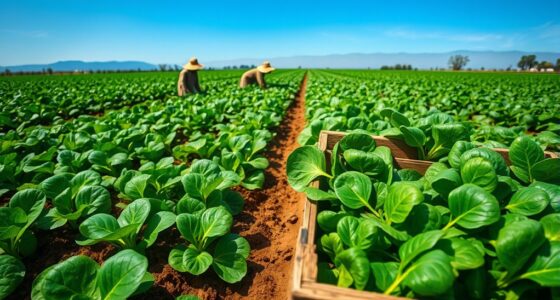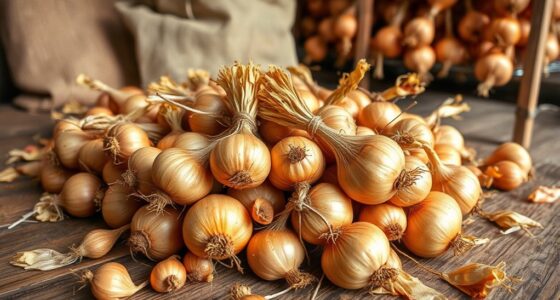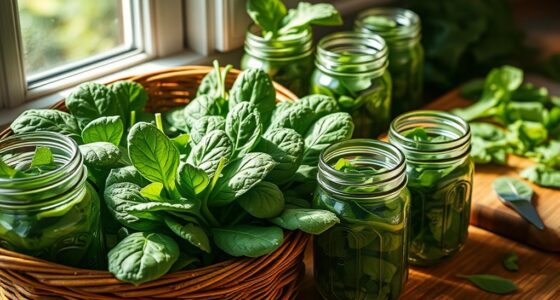Choosing the right mulch for your farm starts with understanding your plants' needs. Consider organic options for improved soil health and nutrients, or inorganic for durability and weed control. Think about your local climate, as it affects mulch breakdown and effectiveness. Aim for a thickness of 2 to 4 inches to suppress weeds without suffocating roots. Regular maintenance and aesthetic appeal are also essential. Stick around to discover more insights on selecting the perfect mulch for your farm.
Key Takeaways
- Assess the unique needs of your plants, considering their moisture, aesthetic, and nutrient requirements when choosing mulch.
- Opt for organic mulch for soil health and nutrient enhancement, while inorganic mulch provides durability and excellent weed control.
- Take local climate conditions into account, as humidity and rainfall affect mulch decomposition and effectiveness.
- Maintain a mulch thickness of 2 to 4 inches to effectively suppress weeds without suffocating plant roots.
- Regularly inspect and replenish mulch to ensure it remains effective and visually appealing throughout the growing season.
Understanding Your Garden's Needs
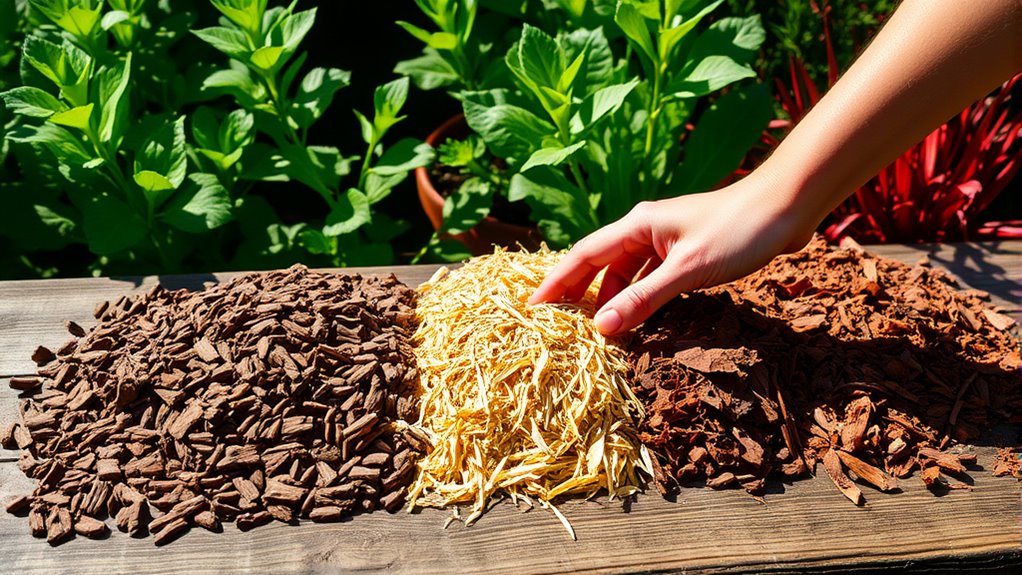
When you assess your garden's needs, keep in mind that different plants have unique requirements.
If you're focusing on vegetable gardens, consider mulch types that promote moisture conservation, as these plants often need consistent hydration.
On the other hand, ornamental plants might benefit more from aesthetic mulch options.
Weed control is essential too; organic materials can suppress weed growth while enhancing soil fertility as they decompose.
Understanding local climate conditions is critical since they affect how quickly mulch breaks down, impacting soil quality over time.
Evaluate the specific plants that need tailored care, ensuring you select the right mulch type to support their growth and health throughout the seasons.
Organic vs. Inorganic Mulch

Choosing the right mulch type directly impacts your garden's health and productivity. Organic mulch, like wood chips and straw, enriches soil health as it decomposes, providing essential nutrients and boosting microbial activity. In contrast, inorganic mulch options, such as gravel and landscape fabric, excel in weed control and durability but don't contribute to soil fertility.
| Type | Benefits |
|---|---|
| Organic Mulch | Improves soil health, adds nutrients |
| Inorganic Mulch | Long-lasting, excellent weed control |
| Maintenance | Requires annual replenishment |
| Climate Impact | Decomposes faster in humid conditions |
Your choice should align with your plants' needs and local climate conditions, ensuring healthy plant roots thrive.
Climate Considerations for Mulching
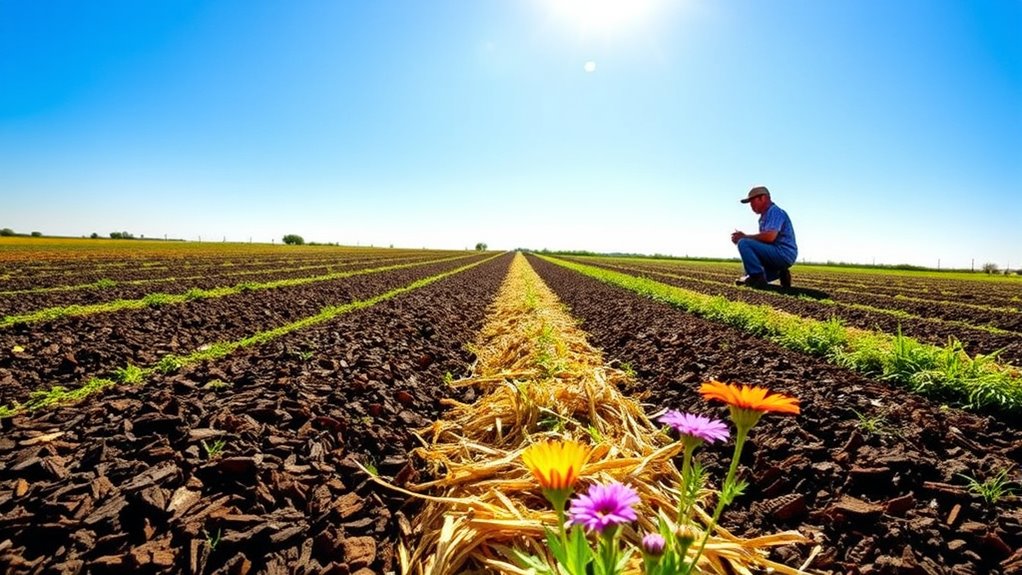
When choosing mulch, you need to take into account your region's weather patterns and seasonal temperature variations.
These factors affect how quickly organic mulches decompose and how well they protect your plants. By understanding your local climate, you can select the right mulch to enhance moisture retention and shield against erosion.
Regional Weather Patterns
Understanding how regional weather patterns affect mulching is essential for optimizing your farm's health and productivity. Your choice of mulch should reflect your regional climate to guarantee effective moisture retention and soil health.
In humid areas, organic mulches break down quickly, while cooler climates slow decomposition. If you face heavy rainfall, consider heavier mulches like stones, which are less likely to wash away than lighter organic options. In hot climates, choose mulches that provide insulation without overheating sensitive plant roots.
Additionally, local pest pressure can guide your selections; organic mulches like cedar can repel insects in warmer regions. A thicker layer of mulch can also offer protection during extreme weather, safeguarding your plants from cold and heat alike.
Seasonal Temperature Variations
As seasonal temperature variations impact your farm, selecting the right mulch becomes essential for protecting your plants.
In colder climates, applying mulch in the fall helps insulate soil and shield root systems from extreme winter temperatures. Conversely, in warmer areas, mulch moderates soil temperature during hot months.
Be cautious with heavy mulches, especially in regions with heavy rain, as they may wash away, making durable materials necessary. Organic mulches enrich your garden with organic matter, but they decompose faster in warmer, humid conditions.
Understanding your local temperature fluctuations can guide your timing; late fall applications provide winter protection, while early spring applications avoid hindering plant emergence.
Choose wisely to guarantee your plants thrive year-round.
Mulch Decomposition Rates
While selecting mulch, it's crucial to take into account how climate affects decomposition rates. Organic mulches decompose faster in humid conditions, breaking down within a year in high rainfall areas. In contrast, they can last several years in arid regions. Warmer temperatures boost microbial activity, further accelerating decomposition.
Consider these emotional factors when choosing your mulch:
- The joy of thriving plants
- The frustration of wasted resources
- The peace of mind from effective insulation
- The fear of extreme weather damage
Inorganic mulches like stone or gravel don't decompose, making them ideal for extreme weather.
Determining Mulch Thickness

How do you know the right thickness for your mulch? The ideal mulch thickness typically ranges from 2 to 4 inches, allowing you to effectively retain moisture and suppress weeds without restricting oxygen access to your plant roots.
Applying mulch too thin mightn't provide adequate weed suppression, while a thicker layer can suffocate roots and lead to moisture retention issues.
Different organic mulches may require varying thickness; for instance, wood chips can be thicker compared to shredded leaves.
If you're in high rainfall areas, a slightly thicker layer can prevent wash away, whereas lighter mulches are better for drier climates to guarantee adequate air circulation.
Regular assessment and replenishment of mulch thickness are crucial as it decomposes over time.
Aesthetic Appeal of Mulch
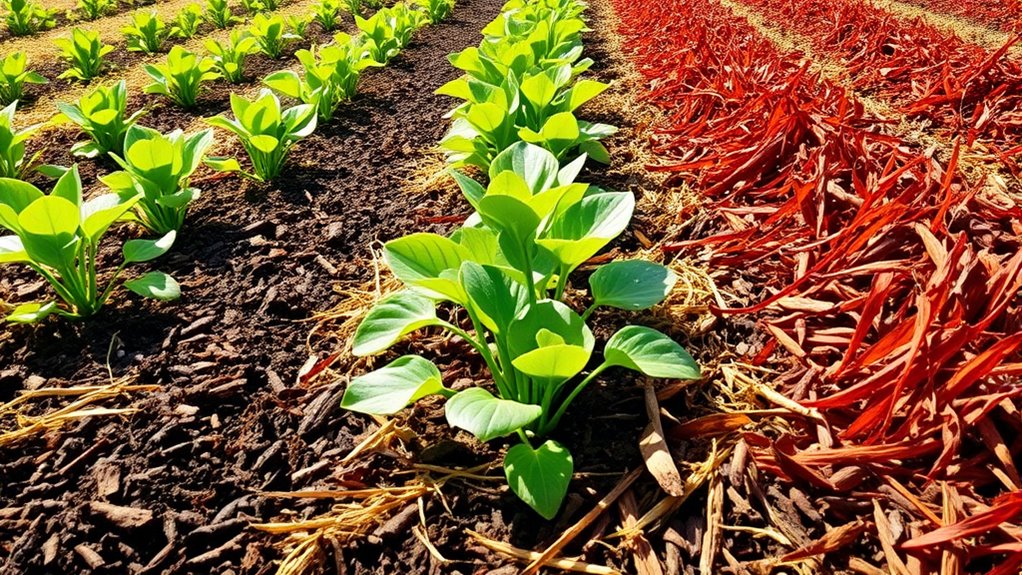
When you choose mulch, color and texture play a big role in the overall look of your landscape.
Dark mulches can make your plants pop, while lighter options blend naturally with the environment.
Adding varied textures can enhance visual interest, creating a dynamic and attractive garden space.
Color Choices Impact Aesthetics
Which color mulch you choose can greatly impact the overall aesthetics of your farm.
Dark-colored mulches, like dark brown or black, can enhance the vibrancy of your plant colors, making your flowers and foliage pop. On the other hand, light-colored mulches, such as straw or natural wood, create a soft, natural look that feels more expansive.
Colored mulches, crafted from non-toxic dye materials, offer a consistent appearance throughout the growing season.
Consider these aspects for aesthetic harmony:
- Enhances vibrancy of plants
- Creates a sense of intimacy or expansiveness
- Complements landscape features
- Aligns with your overall design vision
Choosing the right mulch color can transform your farm's beauty.
Texture Enhances Visual Appeal
While the choice of mulch color is important, the texture can dramatically enhance your farm's visual appeal. Textured mulches, like finely shredded bark or larger wood chips, can create distinct looks—from soft and natural to rugged and rustic.
Dark mulches, such as black or dark brown wood chips, make your plants pop, accentuating their colors beautifully. Organic mulches not only improve soil health but also contribute to the garden's dynamic aesthetic as they change with the seasons.
Plus, textures that allow for air and water exchange, like pine needles or shredded leaves, promote healthy growth. With the right texture, you can elevate your garden design, creating striking contrasts that complement your overall landscape.
Budgeting for Mulch
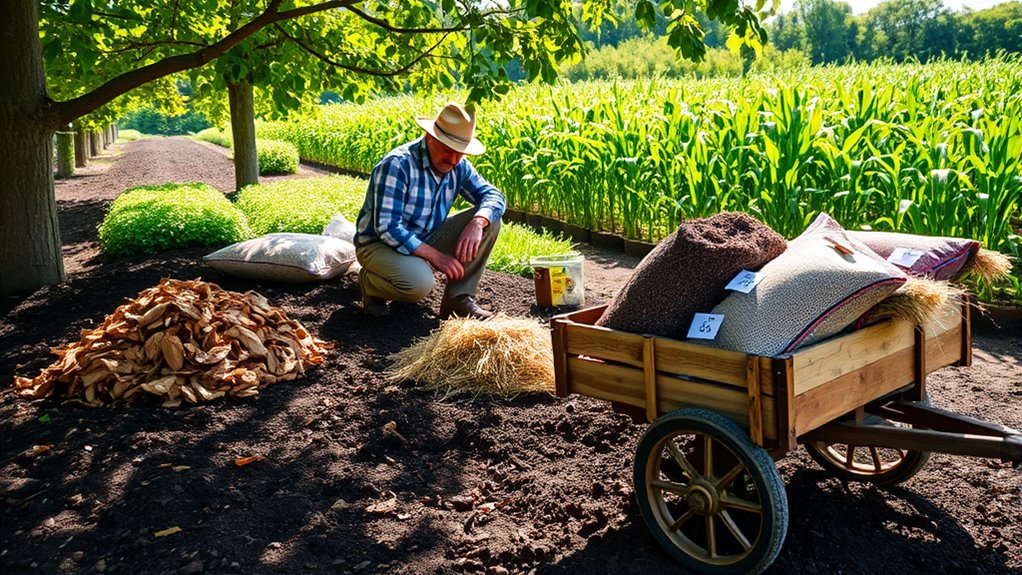
Budgeting for mulch is essential for any farm owner looking to make cost-effective decisions. Start by evaluating the cost per cubic yard of different mulch types. While stone and recycled rubber can strain your budget, wood and bark chips are typically more affordable.
Remember to account for delivery and installation costs, especially for larger areas where bulk orders can enhance cost efficiency.
Consider these emotional factors:
- Saving money for other farm investments
- Creating a sustainable environment
- Supporting local sources and community initiatives
- Enjoying a healthier, thriving landscape
Don't forget the maintenance costs associated with organic mulches, as they require regular replenishing.
Explore options like compost or chipped wood from tree services to help minimize expenses.
Maintenance and Care for Mulch

To keep your mulch effective and beneficial for your plants, regular maintenance is essential. Monitor mulch thickness to maintain an ideal depth of 2-4 inches; too much can restrict oxygen access to roots.
Annually replenish organic mulch, as it decomposes, enhancing soil fertility and ensuring moisture retention while suppressing weed growth. Inspect your mulch regularly for any signs of weed growth or decomposition. Remove weeds promptly and consider renewing the mulch layer if it becomes thin or degraded.
Always maintain a 1-2 inch gap between mulch and plant stems to prevent rot and pest issues. After heavy rains, check for erosion; adjust or replenish as needed to keep your mulch effective and protect your plants.
Frequently Asked Questions
How to Choose the Right Mulch?
To choose the right mulch, assess your garden's specific needs first. Determine if you need moisture retention, weed control, or soil health improvement.
Organic mulches, like shredded bark, enhance soil, while inorganic options, like gravel, offer low maintenance. Consider your local climate, as organic mulches decompose faster in humid areas.
Maintain a thickness of 2 to 4 inches and pick colors that complement your plants to create a visually appealing garden.
How Do I Know What Mulch I Need?
To know what mulch you need, start by evaluating your plants' specific requirements.
Think about whether you want organic mulch to enrich the soil or inorganic options for better weed control.
Consider your local climate, as it influences how fast mulch breaks down.
Aim for a thickness of 2-4 inches to keep moisture in and weeds out.
Finally, pick a color and texture that complements your garden's aesthetics.
What Are the Rules for Mulching?
When you're mulching, aim for a thickness of 2 to 4 inches to retain moisture and suppress weeds effectively.
Regularly check your mulch levels, especially after heavy rain, and avoid piling it against plant bases to prevent rot.
If using grass clippings, keep the depth to 1-2 inches for proper air circulation.
Choose organic or inorganic mulches based on your needs, focusing on improving soil quality or durability.
What Mulch Should Not Be Used?
Imagine a garden thriving under a protective blanket, but some mulches can turn that paradise into a nightmare.
You should avoid dyed wood mulch, as it can leach harmful dyes into your soil.
Shredded tires might seem durable, but they release toxins and create lasting waste.
Rubber mulch can smell unpleasant and is tough to remove.
Finally, steer clear of inorganic options like black plastic, which can scorch roots and hinder moisture absorption.
Conclusion
Choosing the right mulch for your farm isn't just about practicality; it's a chance to enhance your garden's beauty while meeting its needs. Imagine walking through your vibrant rows of crops, the rich aroma of organic mulch mingling with the earthy scent of the soil. You'll notice how the right thickness retains moisture and suppresses weeds, all while staying within your budget. With a little care and maintenance, your garden can thrive, creating a perfect balance between function and aesthetics.




